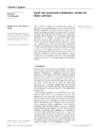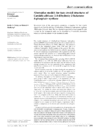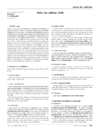issue contents
February 2008 issue

Cover illustration: Active site of exonuclease I at 1.5 Å resolution with a TMP molecule bound. Omit electron density is contoured at 3![[sigma]](/logos/entities/sigma_rmgif.gif) . Also observed is atypical coordination of two critical divalent cations which may be relevant to the mechanism of hydrolysis (p. 206).
. Also observed is atypical coordination of two critical divalent cations which may be relevant to the mechanism of hydrolysis (p. 206).
research papers
Surface-entropy reduction (SER) mutants of the FabF protein from S. pneumoniae were rationally designed to avoid the disruption of the presumably strong interfaces involved in the formation of a high-resolution (1.3 Å) crystal form while at the same time potentially destabilizing an undesirable crystal form. One of the mutant proteins yielded a new crystal form that diffracted to high resolution, underscoring the power of the SER approach in protein and crystal engineering.
PDB reference: β-ketoacyl acyl carrier protein synthase II, 2rjt, r2rjtsf
A series of structures show the development of novel inhibitors of carboxypeptidase B. These inhibitors were designed to mimic peptide-based inhibitors of the protein.
Open  access
access
 access
accessFor the first time, protein microcrystallography has been performed with a focused synchrotron-radiation beam of 1 µm using a goniometer with a sub-micrometre sphere of confusion. The crystal structure of xylanase II has been determined with a flux density of about 3 × 1010 photons s−1 µm−2 at the sample.
PDB reference: xylanase II, 2jic, r2jicsf
A novel methodological development for the analysis, via Raman microscopy, of SeMet-labelled protein crystals is presented.
The computer program SnB, which implements the direct-methods Shake-and-Bake procedure and is part of the protein structure-determination package BnP, has recently been optimized in several ways for more rapid, automated substructure determination.
Crystal structures of unliganded and liganded complexes of the A178L variant of dimeric and monomeric trypanosomal TIM are reported. The A178L point mutation changes the conserved sequence pattern of the C-terminal hinge of the catalytic loop-6. The point mutation causes differences in the apo structures but not in the liganded structures.
Plastic microchannel crystallization template designs made from inexpensive cyclic olefin copolymers have been shown to be low-birefringent, X-ray transmissive and compatible with microfluidic fabrication in restricted geometry. The model proteins thaumatin, lysozyme and bacteriorhodopsin demonstrated the feasibility of conducting counter-diffusion equilibration within the new plastic configuration.
The crystal structure of SCO0332 was determined; functional analysis suggests that SCO0332 is a transcriptional repressor of the sco0330 gene.
PDB reference: SCO0332, 2zb9, r2zb9sf
The structure of Escherichia coli exonuclease I in complex with a nucleotide product, thymidine 5′-monophosphate, is described in an orthorhombic space group at 1.5 Å resolution.
PDB reference: ExoI–TMP, 2qxf, 2qxfsf
The crystal structure of methionine γ-lyase from Citrobacter freundii was determined at 1.35 Å. The high-resolution structure makes it possible to analyze in detail interactions between monomers, a mode of the cofactor binding and participation of the protein flexible regions in substrate recognition and binding.
PDB reference: methionine γ-lyase, 2fng, r2fngsf
short communications
The noncrystallographic symmetry operations reported for two crystal structures of 3,4-dihydroxy-2-butanone 4-phosphate synthase can be reinterpreted as crystallographic operations.
international union of crystallography
Free 



 journal menu
journal menu




























